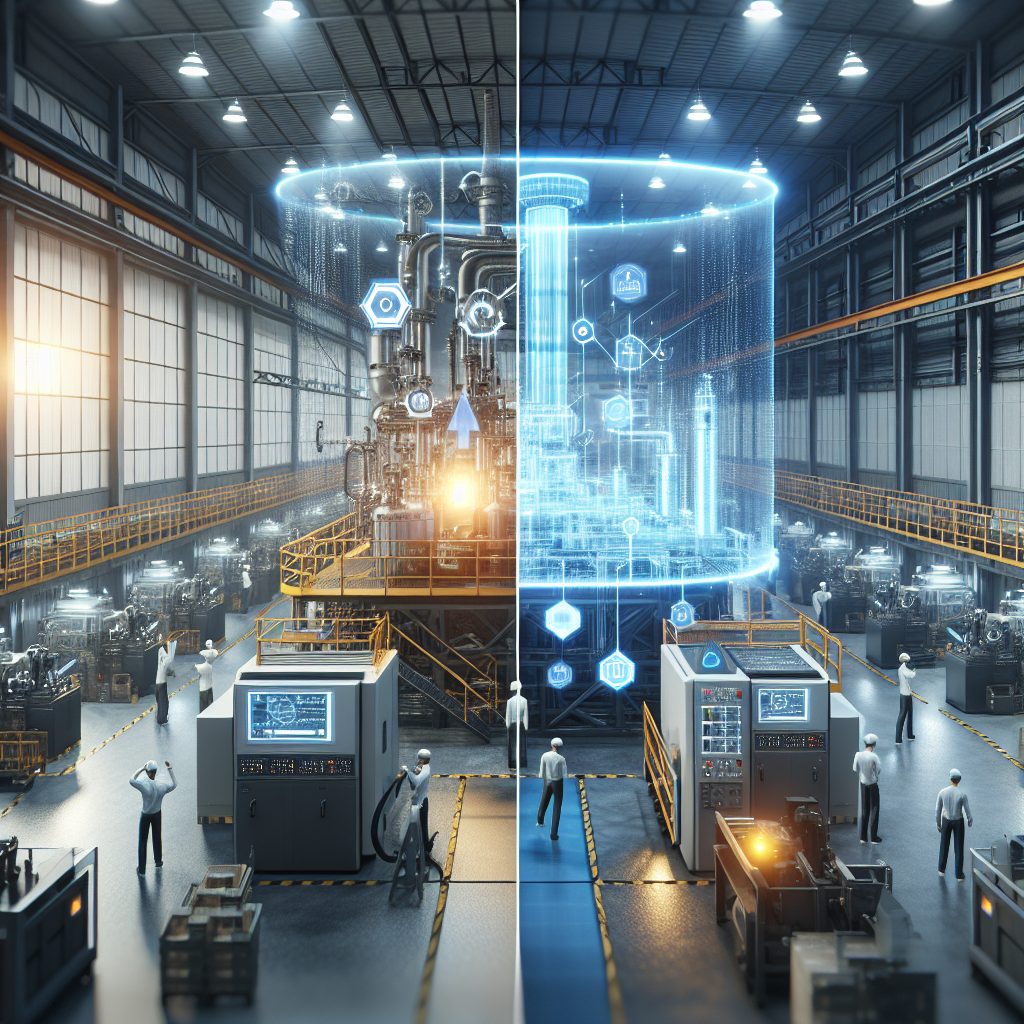In a world where industry meets innovation head-on, digital twins are revolutionizing the landscape of industrial investment. Imagine a virtual replica so sophisticated, it mirrors every nuance of a physical asset or system. This isn’t science fiction; it’s the power of digital twin technology, a game-changer for investors and engineers alike. As you explore this article, expect to uncover how these dynamic models not only predict and optimize performance but also open doors to unprecedented levels of efficiency and insight.
If you’ve ever wondered how investments keep pace with the breakneck speed of technological advancement, digital twins hold the key. They’re not just fancy buzzwords—they’re intricate tools that provide a crystal-clear view into complex processes and potential improvements. Here, we’ll dive into the nitty-gritty of how constructing these virtual counterparts can lead to smarter decisions and beefed-up bottom lines. Whether you’re in manufacturing, healthcare, or urban planning, getting savvy with digital twins could mean the difference between leading the pack and playing catch-up. So buckle up; we’re about to take a deep dive into the future of industrial strategy.
Important Highlights
1. Digital twins are revolutionizing the industrial sector by creating virtual replicas of physical assets, systems, or processes, enabling companies to optimize their operations in real-time. This innovative technology allows for predictive maintenance, reducing downtime and saving costs by foreseeing potential issues before they arise.
2. Investment in digital twin technology is surging as it promises to enhance efficiency and innovation across various industries such as manufacturing, healthcare, and urban planning. By simulating real-world scenarios, businesses can test the performance of products and infrastructure in a virtual environment, leading to improved product development and operational planning.
3. The integration of Internet of Things (IoT) with digital twins has been a game-changer, facilitating the continuous exchange of data between the physical and virtual worlds. This synergy ensures that the digital twin evolves in accordance with its physical counterpart, thereby providing up-to-date insights for better decision-making.
4. Customization and scalability are key advantages of digital twin technology; it’s not a one-size-fits-all solution but instead can be tailored to meet the specific needs of any business size or type. As companies grow and change, their digital twins can adapt accordingly, ensuring long-term relevance and return on investment.
5. With environmental concerns on the rise, digital twins offer a sustainable approach to industrial development by minimizing waste during production processes and optimizing energy consumption. This eco-friendly angle not only supports global sustainability efforts but also aligns with consumer demand for responsible corporate practices.
Understanding Digital Twins in Industrial Investment
Digital twins are revolutionizing the way industries invest and operate. A digital twin is a virtual model designed to accurately reflect a physical object or system. Industries leverage these models to simulate, predict, and optimize systems before investing in physical assets. This technology enables stakeholders to make informed decisions by visualizing the impacts of potential changes on real-world operations.
Application Areas for Digital Twins
The application of digital twins spans numerous sectors including manufacturing, healthcare, automotive, and urban planning. In manufacturing, digital twins help in product design, production process optimization, and predictive maintenance. For instance, using a digital twin of a production line can highlight efficiency bottlenecks and reduce downtime by predicting equipment failure before it occurs. Similarly, in healthcare, creating virtual replicas of organs aids surgeons in planning complex procedures.
Integrating IoT with Digital Twins
The integration of the Internet of Things (IoT) devices with digital twins forms a dynamic data ecosystem. Sensors collect real-time data from physical assets which is then fed into the digital twin for analysis. This ongoing flow allows for continuous monitoring and adjustment of systems to maintain optimal performance levels.
Enhancing Predictive Analytics
Digital twins elevate predictive analytics beyond traditional methods. By incorporating machine learning algorithms and historical data, they provide accurate forecasts for wear and tear on machinery or anticipate market demand shifts. These insights drive strategic investment decisions that minimize risk and capitalize on emerging opportunities.
Cost Savings and ROI Enhancement
Implementing digital twins leads to significant cost savings by identifying inefficiencies and reducing waste. They enable just-in-time inventory management, lower energy consumption, and extend the lifespan of equipment through timely maintenance. The return on investment (ROI) becomes more tangible as companies avoid unnecessary expenses and improve their bottom lines through enhanced operational intelligence.
Fostering Sustainable Practices
Digital twins contribute to sustainability goals by optimizing resource usage and reducing emissions. Companies can test different scenarios virtually to find the most eco-friendly approaches without compromising productivity or quality.
Data Security Considerations
While leveraging digital twins offers numerous advantages, it is crucial to ensure robust data security measures are in place. Protecting sensitive information associated with digital twin technologies from cyber threats is paramount for maintaining trust and integrity within industrial investment strategies.
Cross-Industry Collaboration Opportunities
The versatility of digital twins creates opportunities for cross-industry collaboration. Shared insights can lead to innovations that propel multiple sectors forward simultaneously—like aerospace working alongside automotive experts to develop new materials or energy-efficient propulsion systems.
Future Developments in Digital Twin Technology
The future promises further advancements in digital twin technology with greater interoperability among systems and more sophisticated simulation capabilities. As computing power increases, so too will the complexity and accuracy of digital twin models, leading to even more strategic investment opportunities.
Tips for Implementing Digital Twins Successfully:
- Analyze your specific industry needs to determine how a digital twin can best serve your business objectives.
- Incorporate high-quality sensors and reliable IoT networks to ensure accurate data feeds into your digital twin.
- Invest in cybersecurity measures to protect your virtual models from unauthorized access or tampering.
- Consider partnering with other industries where applicable to share knowledge and resources when developing digital twins.
- Stay updated on technological advancements in artificial intelligence and machine learning that could enhance your digital twin’s predictive analytics capabilities.
- Prioritize scalability when designing your digital twin framework to accommodate future growth or diversification.
Frequently Asked Questions
What are digital twins?
Digital twins are virtual models of a process, product, or service. They mirror the physical world, allowing industries to simulate and analyze their systems in a virtual space before applying changes in reality.
How do digital twins affect industrial investment?
They revolutionize industrial investment by providing precise data for better decision-making, optimizing operations, reducing costs, and enhancing innovation. This results in smarter investments and stronger returns.
Can digital twins predict equipment failure?
Absolutely. By analyzing real-time data and historical performance, digital twins can foresee potential breakdowns, leading to proactive maintenance and reduced downtime.
Are digital twins costly to implement?
The initial setup can be an investment; however, the long-term savings from efficiency gains often outweigh the initial costs. Plus, there are scalable options suitable for various budgets.
Is specialized knowledge required to use digital twins?
While some technical know-how is beneficial, many systems are designed with user-friendly interfaces. Training is usually provided to ensure teams can fully leverage the technology.
Do digital twins enhance sustainability?
Indeed they do. They allow for more efficient resource use and help in pinpointing areas where waste can be reduced, thus promoting sustainable practices within industries.
How secure are digital twins from cyber threats?
Data security is a priority. Providers incorporate robust security measures to protect against cyber threats, but it’s also crucial for users to maintain good cybersecurity practices.
Can small businesses benefit from digital twins?
Certainly! Even small businesses can harness the power of digital twins to optimize their processes and remain competitive in today’s market.
How Can Digital Twins Enhance the Value of Digital Gold Investments?
Digital twins offer a revolutionary approach to managing digital gold investments. By creating virtual replicas of assets, they enable investors to simulate market scenarios and optimize strategies. As alternative investments transforming the digital landscape, digital twins enhance decision-making, improve risk assessment, and ultimately increase the value of these innovative financial assets.
In what industries are digital twins most commonly used?
Manufacturing, healthcare, automotive, aerospace, and construction are leading the charge in adopting digital twin technology.
How will digital twins evolve in the future?
The technology is expected to grow smarter with advancements in AI and machine learning, integrating deeper into daily operations and offering even more value across diverse sectors.
Closing Reflections on Digital Twins
Digital twins stand at the forefront of industrial innovation, reshaping how we invest in and manage our resources. As this technology continues to mature, we’ll likely see an increased uptake across all levels of business – driving efficiency and fostering more informed investment strategies. The horizon looks promising for those who embrace this virtual counterpart of our physical world.
The fusion of the virtual and physical realms through digital twins not only paves the way for enhanced operational control but also signals a shift towards intelligent investment decisions that could define the future of industry. Embracing this technological advance means stepping into a realm of endless possibilities where improved performance and strategic foresight become the norm.

